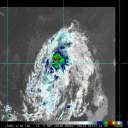Show Selection:
|
#906636 (Received by flhurricane at: 4:49 AM 11.Oct.2017)
TCDAT2
Tropical Storm Ophelia Discussion Number 9
NWS National Hurricane Center Miami FL AL172017
500 AM AST Wed Oct 11 2017
Ophelia has become better organized during the past several hours,
with convective banding now wrapping almost all of the way around
the center. Satellite intensity estimates from TAFB and SAB have
increased to 55 kt and 65 kt, respectively, and several recent
microwave-based intensity estimates are in the 55-65 kt range.
Based on this, the initial intensity is increased to a possibly
conservative 55 kt.
The initial motion is now 125/5. Ophelia should continue to move
southeastward or east-southeastward during the next 12-24 hours with
a decrease in forward speed while it remains embedded within a mid-
to upper-level trough to the south of the mid-latitude westerlies.
After that, the cyclone is forecast to turn northeastward and
accelerate by day 3 ahead of a deepening mid-latitude trough over
the north-central Atlantic. The latest track guidance is in good
agreement with this scenario. However, there has been a significant
northward shift in the 120 h forecasts since the last advisory. The
new official forecast track is similar to the previous track through
72 h, and then is adjusted northward at the 96 and 120 h points. It
should be noted, though, that the 120 h point is to the south of the
consensus and large-scale models, and additional northward
adjustments may be required later.
The cyclone is expected to be within a low shear environment and
over marginally warm sea surface temperatures during the next 2 to 3
days. These conditions favor strengthening and the NHC forecast
now calls for Ophelia to become a hurricane in about 24 hours.
Extratropical transition is likely to start around day 4 and be
complete by day 5, with the associated baroclinic dynamics expected
to keep Ophelia a strong cyclone over the northeastern Atlantic.
FORECAST POSITIONS AND MAX WINDS
INIT 11/0900Z 30.2N 37.0W 55 KT 65 MPH
12H 11/1800Z 29.9N 36.4W 60 KT 70 MPH
24H 12/0600Z 30.1N 35.9W 65 KT 75 MPH
36H 12/1800Z 30.5N 35.3W 75 KT 85 MPH
48H 13/0600Z 31.2N 34.0W 75 KT 85 MPH
72H 14/0600Z 33.5N 28.5W 70 KT 80 MPH
96H 15/0600Z 37.5N 20.5W 70 KT 80 MPH
120H 16/0600Z 43.0N 13.0W 65 KT 75 MPH...POST-TROP/EXTRATROP
$$
Forecaster Beven |



